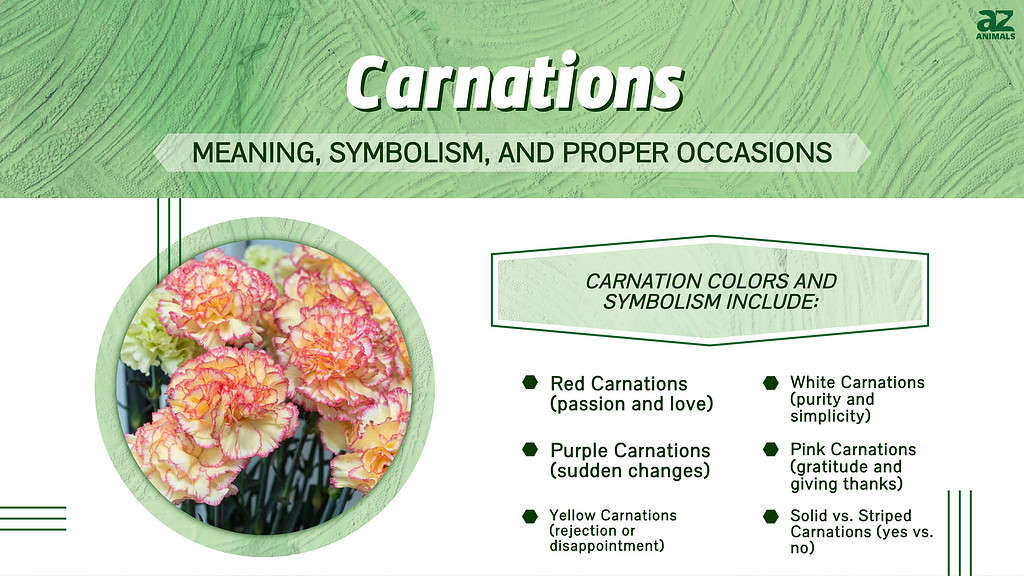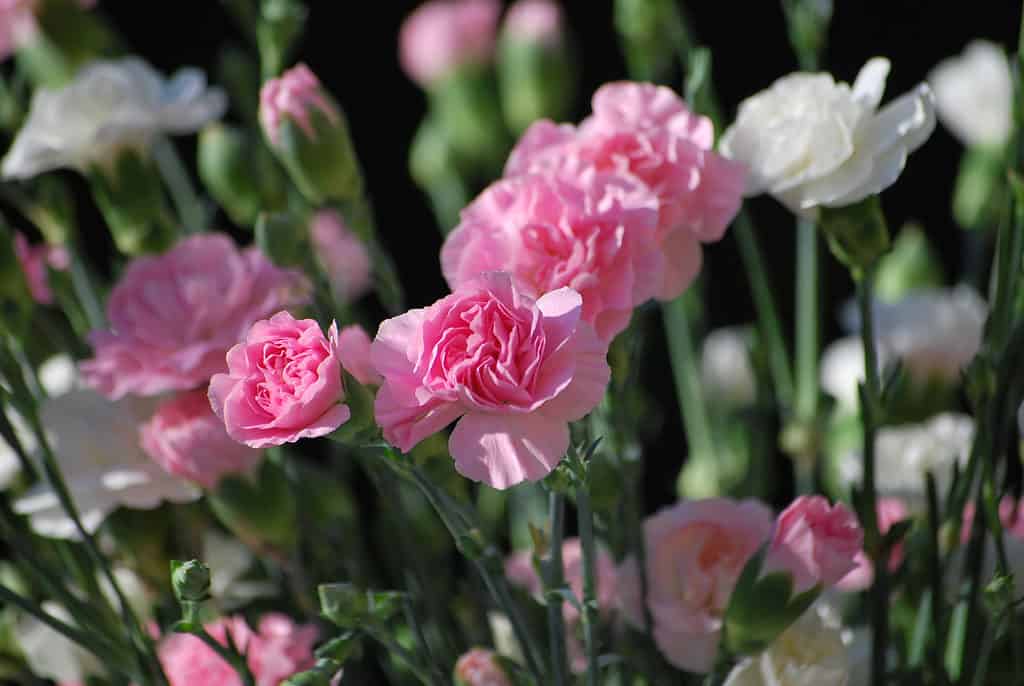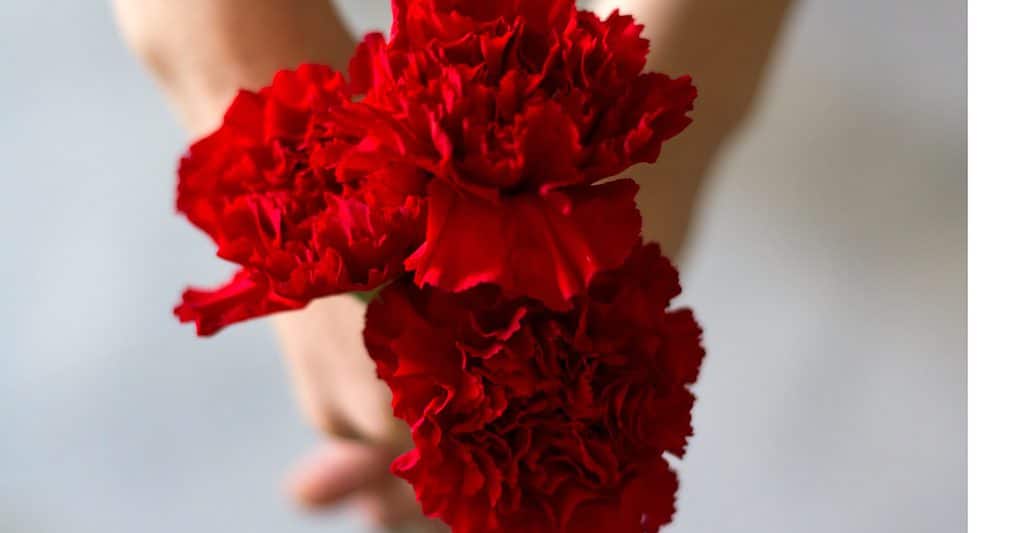People have been growing carnations for thousands of years. Because of this, their native range is not exactly known. Some experts believe that they originally came from the Mediterranean area. These beautiful and colorful flowers have a long history of ceremonial use, special meaning, and symbolism.

Carnations in Ancient History
The carnation is such an important flower that several ancient civilizations had myths about its creation.
Carnations in Ancient Greece
In Ancient Greek mythology, carnations had a gruesome beginning. Diana, the goddess of animals and hunting, fell in love with a shepherd. When he didn’t return her feelings, she killed him by plucking out his eyes. She left his body on the ground. According to Greek legend, the first carnations grew from his remains.

Carnations have been an important flower for thousands of years.
©YULIYAPHOTO/Shutterstock.com
Despite their violent beginnings, these flowers were very important in Ancient Greek culture. People wore them on ceremonial crowns, which may be the origin of the flower’s modern name. Some people believe the name carnation comes from the Greek κορώνη, or korone, which means a garland or crown.
The scientific name for carnations, Dianthus, is a combination of the Greek words for god and flower. This has led to the nickname “flower of god.”
Carnations in Ancient Rome
In Ancient Rome, carnations symbolized victory, especially in war. When soldiers would return, victorious, women would meet them with bouquets of carnations and weave the flowers into their own hair. Ancient Romans also believed carnations symbolized love. They would give the flowers as a symbol of affection.
Some people believe the name carnation has its origins in Ancient Rome. The Latin words caro and carnis mean flesh, and the original carnations were a fleshy pink color.
Carnations in Christianity
According to Christian beliefs, carnations first sprouted where the Virgin Mary’s tears fell during Jesus’ crucifixion. Some believe this is the actual origin of the name carnation. The Latin word incarnatio means incarnation and may be a reference to Jesus being an incarnation of god in the flesh.
Carnations in Modern History

People often wear red carnations on May Day.
©iStock.com/rfranca
While the original carnations only came in various shades of pink and flesh tones, today, they come in a rainbow span of colors. In 1907, Anna Jarvis, the creator of Mother’s Day, designated carnations as the official flower of the holiday. In Korea, Mother’s Day and Father’s Day are combined into one holiday called Parent’s Day. Carnations are also a popular flower for this day.
Some people wear red carnations on May 1st, which is May Day. This holiday is also known as International Workers’ Day. The red carnations are a show of support for socialism or worker’s rights. Wearing a red carnation on May Day is especially popular in Austria and Italy. The red rose is also a symbol for this day.
Red carnations are also a symbol of the Carnation Revolution which took place in Portugal on April 25, 1974. This revolution got its name because there were almost no casualties or even shots fired. After the soldiers were celebrating their victory in the streets, a restaurant server and pacifist, Celeste Caiero, passed out red and white carnations. People put the flowers in the muzzles of the soldiers’ guns, on their uniforms.
In Ireland, green carnations are a symbol of St. Patrick’s Day. People often wear them to celebrate the holiday.
Green carnations may also be a symbol of being part of the queer community. Oscar Wilde, a famous playwright, and poet, was gay in Ireland when having gay sex was still illegal. It is rumored that he told several of his friends to wear green carnations on their jackets to the opening night of his play Lady Windermere’s Fan in 1892. The rumor is that meant this as a subtle symbol that they were open to dating men.
Carnations are the official flower of the countries Spain, Slovenia, and Monaco. It is also the official flower of the state of Ohio.
Carnation Colors & Symbolism

Carnations with a striped pattern symbolize rejection.
©Tamara Kulikova/Shutterstock.com
In general, carnation meaning includes different kinds of love. It can be a symbol of romantic love, familial love, or the special love that you have for a friend. Different colors of carnations also have different meanings. This practice started in the Victorian era. People would give flower arrangements with hidden messages based on the color and type of flowers used.
- Red Carnations: This is the color of passion and love. Red carnations have various meanings. The exact meaning depends on the context in which you are using it.
- Red carnations are a symbol of socialism and workers’ rights in some countries.
- Light red carnations symbolize admiration from afar, or missing someone.
- Dark red carnations represent passion and love.
- In Islam, some believe that red carnations and tulips are a symbol of god and Muhammed. So, there are many paintings of these flowers in Turkish mosques.
- White Carnations: In general, white represents purity, divinity, and spirituality in some cultures. However, in Japan and China white symbolizes death and sadness. Giving a white carnation may mean:
- A pure and innocent love.
- General purity and simplicity.
- Good luck and prosperity.
- In the Netherlands, white carnations are a symbol of veterans of WWII.
- Purple Carnations: People often associated the color purple with royalty and luxury. However, their meaning is different when associated with carnations:
- Purple carnations symbolize sudden changes.
- In France, purple carnations are also associated with funerals and death.
- Pink Carnations: Pink is generally associated with sweetness and innocent love. However, pink carnations have a slightly different meaning.
- They symbolize gratitude or giving thanks.
- Pink carnations also symbolize that you appreciate someone and will never forget them.
- Yellow Carnations: While yellow roses are a symbol of friendship, yellow carnations may be a disappointment to those who receive them.
- Yellow carnations symbolize rejection.
- They also mean the giver is disappointed with the recipient.
- Striped Carnations: Carnations with this pattern mean a “no” answer or rejection.
- Solid Carnations: A solid carnation means a “yes” or affirmative answer.
Which Occasions Are Carnations For?
People traditionally give certain flowers on certain holidays and special events. You can give these flowers on those days as a thoughtful gift. You can also give carnations on:
- Mother’s Day
- 1st Wedding Anniversary
- January Birthdays
- Carnation Day (January 29th)
- St. Patrick’s Day (Green carnations)
- Funerals & Times of Bereavement (Especially in France)
There are also special occasions that are a great time to give carnations, perhaps as part of a flower arrangement with other types of flowers, to send a unique message:
- Housewarming
- First Date
- An Apology
- Showing Appreciation
- Sending Congratulations
- Other Birthdays
- Other Anniversaries
The photo featured at the top of this post is © yoshi0511/Shutterstock.com
Thank you for reading! Have some feedback for us? Contact the AZ Animals editorial team.






